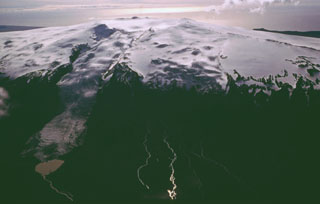Report on Eyjafjallajokull (Iceland) — 19 May-25 May 2010
Smithsonian Institution / US Geological Survey
Weekly Volcanic Activity Report, 19 May-25 May 2010
Managing Editor: Sally Sennert.
Please cite this report as:
Global Volcanism Program, 2010. Report on Eyjafjallajokull (Iceland) (Sennert, S, ed.). Weekly Volcanic Activity Report, 19 May-25 May 2010. Smithsonian Institution and US Geological Survey.
Eyjafjallajokull
Iceland
63.633°N, 19.633°W; summit elev. 1651 m
All times are local (unless otherwise noted)
The Nordic Volcanological Center (NVC) at the Institute of Earth Sciences reported that during 19-24 May overall activity from Eyjafjallajökull declined, and deformation measurements indicated subsidence. During 19-20 May gray ash plumes rose to altitudes of 5-6 km (16,400-19,700 ft) a.s.l. and drifted NW, N, and NE. Ashfall was reported in areas to the S, NW, and N. On 19 May heavy rainfall combined with ashfall to cause a mudslide in a local river. During 21-22 May light gray plumes with small amounts of ash rose to altitudes of 3-4 km (9,800-13,100 ft) a.s.l. No ashfall was reported. Some explosions occurred in the summit crater those days, but no lava flows. Seismicity continued to decrease and approached pre-eruption levels. White steam plumes rose from the crater during 23-25 May, though a small ash explosion was seen by scientists visiting the crater on 25 May.
Geological Summary. Eyjafjallajökull (also known as Eyjafjöll) is located west of Katla volcano. It consists of an elongated ice-covered stratovolcano with a 2.5-km-wide summit caldera. Fissure-fed lava flows occur on both the E and W flanks, but are more prominent on the western side. Although the volcano has erupted during historical time, it has been less active than other volcanoes of Iceland's eastern volcanic zone, and relatively few Holocene lava flows are known. An intrusion beneath the S flank from July-December 1999 was accompanied by increased seismic activity. The last historical activity prior to an eruption in 2010 produced intermediate-to-silicic tephra from the central caldera during December 1821 to January 1823.
Source: Institute of Earth Sciences

